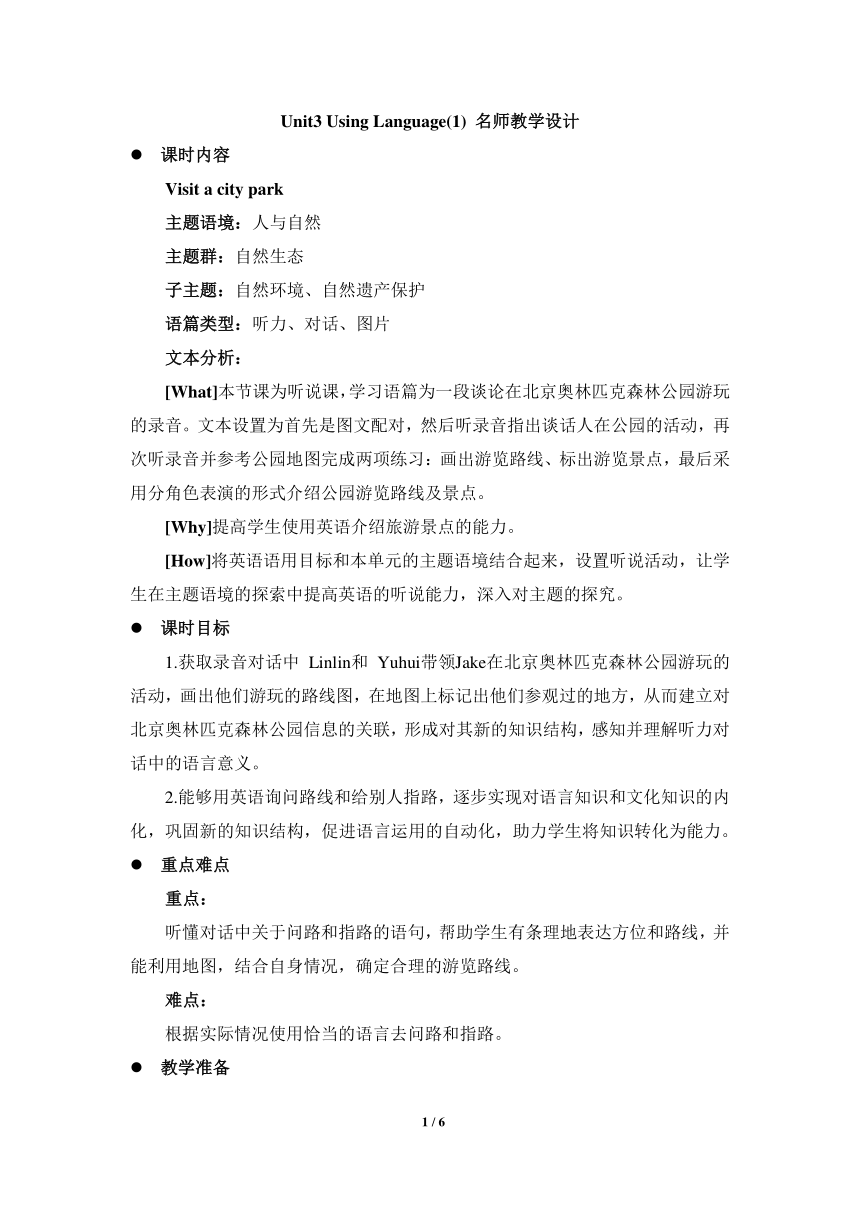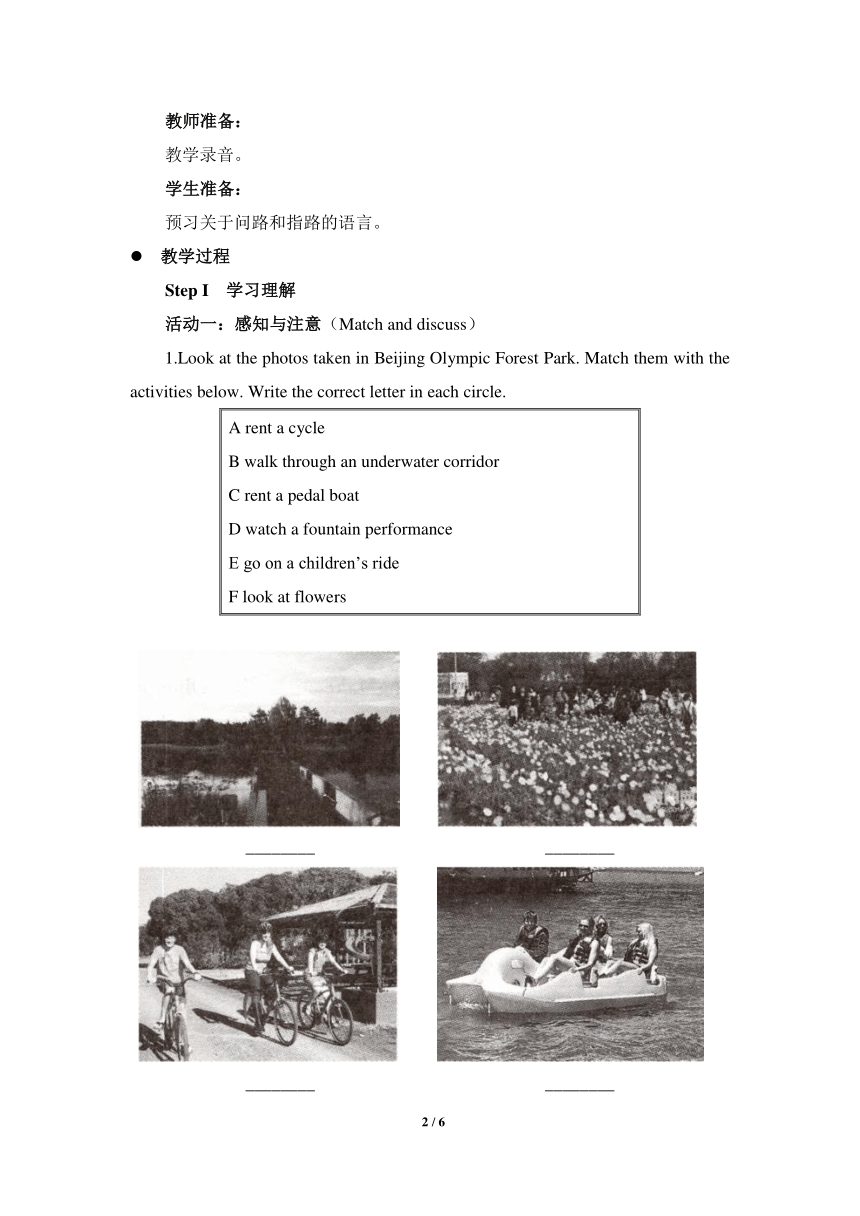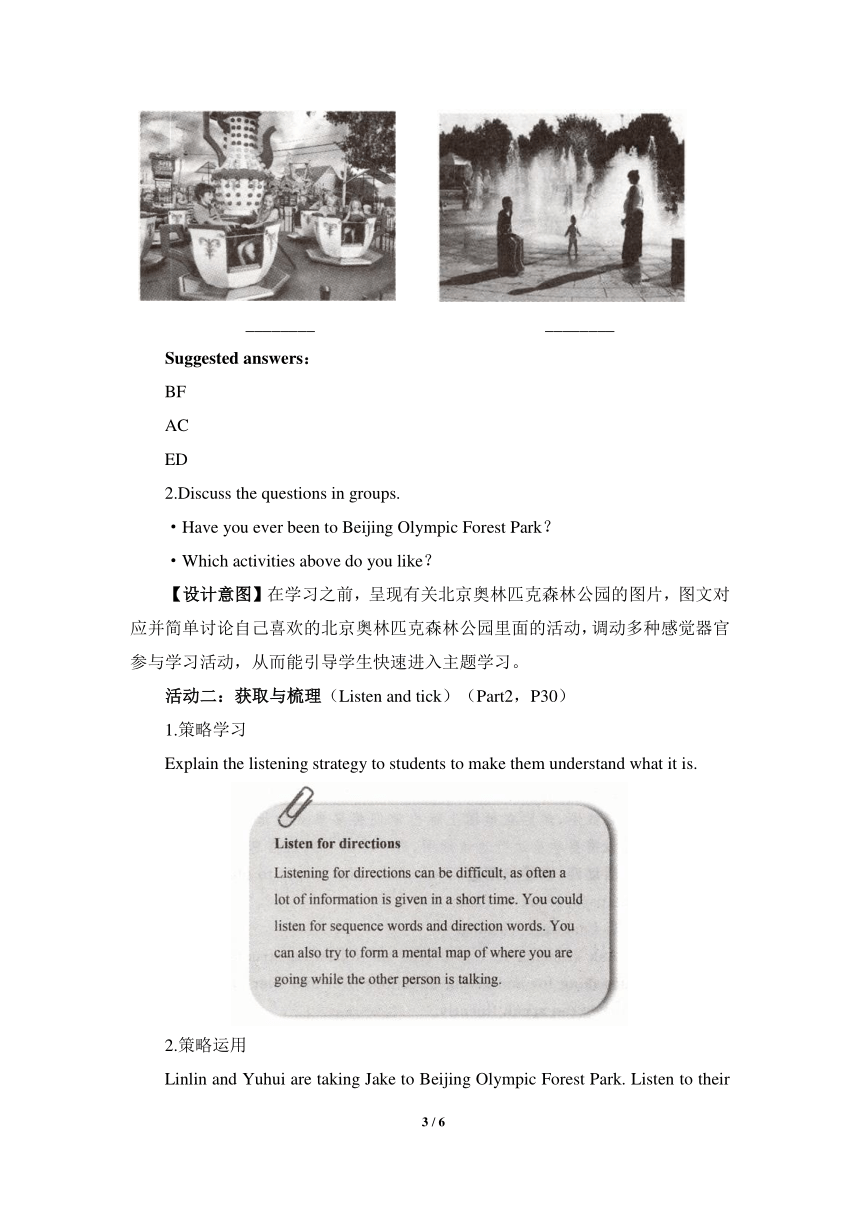人教版(2019)选择性必修第一册 Unit3 Fascinating Parks Using Language(1) 名师教学设计
文档属性
| 名称 | 人教版(2019)选择性必修第一册 Unit3 Fascinating Parks Using Language(1) 名师教学设计 |  | |
| 格式 | docx | ||
| 文件大小 | 2.2MB | ||
| 资源类型 | 教案 | ||
| 版本资源 | 人教版(2019) | ||
| 科目 | 英语 | ||
| 更新时间 | 2023-03-11 19:42:26 | ||
图片预览



文档简介
Unit3 Using Language(1) 名师教学设计
课时内容
Visit a city park
主题语境:人与自然
主题群:自然生态
子主题:自然环境、自然遗产保护
语篇类型:听力、对话、图片
文本分析:
[What]本节课为听说课,学习语篇为一段谈论在北京奥林匹克森林公园游玩的录音。文本设置为首先是图文配对,然后听录音指出谈话人在公园的活动,再次听录音并参考公园地图完成两项练习:画出游览路线、标出游览景点,最后采用分角色表演的形式介绍公园游览路线及景点。
[Why]提高学生使用英语介绍旅游景点的能力。
[How]将英语语用目标和本单元的主题语境结合起来,设置听说活动,让学生在主题语境的探索中提高英语的听说能力,深入对主题的探究。
课时目标
1.获取录音对话中 Linlin和 Yuhui带领Jake在北京奥林匹克森林公园游玩的活动,画出他们游玩的路线图,在地图上标记出他们参观过的地方,从而建立对北京奥林匹克森林公园信息的关联,形成对其新的知识结构,感知并理解听力对话中的语言意义。
2.能够用英语询问路线和给别人指路,逐步实现对语言知识和文化知识的内化,巩固新的知识结构,促进语言运用的自动化,助力学生将知识转化为能力。
重点难点
重点:
听懂对话中关于问路和指路的语句,帮助学生有条理地表达方位和路线,并能利用地图,结合自身情况,确定合理的游览路线。
难点:
根据实际情况使用恰当的语言去问路和指路。
教学准备
教师准备:
教学录音。
学生准备:
预习关于问路和指路的语言。
教学过程
Step I 学习理解
活动一:感知与注意(Match and discuss)
1.Look at the photos taken in Beijing Olympic Forest Park. Match them with the activities below. Write the correct letter in each circle.
A rent a cycle B walk through an underwater corridor C rent a pedal boat D watch a fountain performance E go on a children’s ride F look at flowers
________ ________
________ ________
________ ________
Suggested answers:
BF
AC
ED
2.Discuss the questions in groups.
·Have you ever been to Beijing Olympic Forest Park?
·Which activities above do you like?
【设计意图】在学习之前,呈现有关北京奥林匹克森林公园的图片,图文对应并简单讨论自己喜欢的北京奥林匹克森林公园里面的活动,调动多种感觉器官参与学习活动,从而能引导学生快速进入主题学习。
活动二:获取与梳理(Listen and tick)(Part2,P30)
1.策略学习
Explain the listening strategy to students to make them understand what it is.
2.策略运用
Linlin and Yuhui are taking Jake to Beijing Olympic Forest Park. Listen to their conversation. Tick which activities they are going to do above.
A rent a cycle ________ B walk through an underwater corridor ________ C rent a pedal boat ________ D watch a fountain performance ________ E go on a children’s ride ________ F look at flowers ________
Suggested answers:
BAC
【设计意图】播放录音,获取对话中人物在奥林匹克森林公园中的游览路线以及参与的活动,并勾出他们要做的活动。这个过程有助于提高学生听力理解的能力。
Step Ⅱ 应用实践
活动三:分析与判断(Draw and mark)(Part3,P30)
Look at the map. Listen to the conversation again and finish the activities below.
①Draw the route that Jake,Linlin,and Yuhui will take.
②Mark the places they will visit on the map below.
Suggested answers:
(略)
【设计意图】该活动的主要目的是让学生一边听一边画出路线图,然后在地图上标出他们将要参观的地点,这个过程需要学生边听边读地图,进行分析和判断信息。
活动四:描述与阐述(Talk about how to get to places in the park)(Part 4,P31)
1.Language learning.
Ask students to try to read the following structures about asking for and giving directions over and over again until they can speak fluently.
Asking for and giving directions Excuse/Pardon me. Do you happen to know where…is How do I get to... How far is... Is…nearby Is…close to… Is…far from… It's on the north/south/east/west side of the park. It's about…metres north of… Go through… Walk/Go along the river/path… Follow the (main) path to… When you see the..., you are close to… It’s…metres from here. Go straight ahead (until you come to...).
2.Role-play.
Work in pairs. Role-play visiting the park. Take turns giving directions to different places in the parl.
【设计意图】在口语对话之前,教师帮助学生收集一些问路和指路的词汇和语句,学生通过思考和积累,获取这些语用知识,为口语活动提供背景常识和语言结构,使得有话可说。然后分角色表演游览公园,轮流交换问路和指路,在这个过程中,学生逐步实现对语言知识和文化知识的内化,促进语言运用的自动化,有助于学生将知识转化为能力。
Step Ⅲ 迁移创新
活动五:想象与创造(Write)
Write a passage about a park,focusing on the route to the park and a scenic spot.
【设计意图】让学生写一篇关于介绍公园路线和景点的短文,目的是让学生在新的语境中表达自己的观点、情感等,实现深度学习,促进能力向素养转变。
板书设计
Unit 3 Fascinating Parks Period Ⅳ Using Language(1) I.学习理解 活动一:感知与注意(Match and discuss) 活动二:获取与梳理(Listen and tick) Ⅱ.应用实践 活动三:分析与判断(Draw and mark) 活动四:描述与阐述(Talk about how to get to places in the park) Ⅲ.迁移创新 活动五:想象与创造(Write)
2 / 2
课时内容
Visit a city park
主题语境:人与自然
主题群:自然生态
子主题:自然环境、自然遗产保护
语篇类型:听力、对话、图片
文本分析:
[What]本节课为听说课,学习语篇为一段谈论在北京奥林匹克森林公园游玩的录音。文本设置为首先是图文配对,然后听录音指出谈话人在公园的活动,再次听录音并参考公园地图完成两项练习:画出游览路线、标出游览景点,最后采用分角色表演的形式介绍公园游览路线及景点。
[Why]提高学生使用英语介绍旅游景点的能力。
[How]将英语语用目标和本单元的主题语境结合起来,设置听说活动,让学生在主题语境的探索中提高英语的听说能力,深入对主题的探究。
课时目标
1.获取录音对话中 Linlin和 Yuhui带领Jake在北京奥林匹克森林公园游玩的活动,画出他们游玩的路线图,在地图上标记出他们参观过的地方,从而建立对北京奥林匹克森林公园信息的关联,形成对其新的知识结构,感知并理解听力对话中的语言意义。
2.能够用英语询问路线和给别人指路,逐步实现对语言知识和文化知识的内化,巩固新的知识结构,促进语言运用的自动化,助力学生将知识转化为能力。
重点难点
重点:
听懂对话中关于问路和指路的语句,帮助学生有条理地表达方位和路线,并能利用地图,结合自身情况,确定合理的游览路线。
难点:
根据实际情况使用恰当的语言去问路和指路。
教学准备
教师准备:
教学录音。
学生准备:
预习关于问路和指路的语言。
教学过程
Step I 学习理解
活动一:感知与注意(Match and discuss)
1.Look at the photos taken in Beijing Olympic Forest Park. Match them with the activities below. Write the correct letter in each circle.
A rent a cycle B walk through an underwater corridor C rent a pedal boat D watch a fountain performance E go on a children’s ride F look at flowers
________ ________
________ ________
________ ________
Suggested answers:
BF
AC
ED
2.Discuss the questions in groups.
·Have you ever been to Beijing Olympic Forest Park?
·Which activities above do you like?
【设计意图】在学习之前,呈现有关北京奥林匹克森林公园的图片,图文对应并简单讨论自己喜欢的北京奥林匹克森林公园里面的活动,调动多种感觉器官参与学习活动,从而能引导学生快速进入主题学习。
活动二:获取与梳理(Listen and tick)(Part2,P30)
1.策略学习
Explain the listening strategy to students to make them understand what it is.
2.策略运用
Linlin and Yuhui are taking Jake to Beijing Olympic Forest Park. Listen to their conversation. Tick which activities they are going to do above.
A rent a cycle ________ B walk through an underwater corridor ________ C rent a pedal boat ________ D watch a fountain performance ________ E go on a children’s ride ________ F look at flowers ________
Suggested answers:
BAC
【设计意图】播放录音,获取对话中人物在奥林匹克森林公园中的游览路线以及参与的活动,并勾出他们要做的活动。这个过程有助于提高学生听力理解的能力。
Step Ⅱ 应用实践
活动三:分析与判断(Draw and mark)(Part3,P30)
Look at the map. Listen to the conversation again and finish the activities below.
①Draw the route that Jake,Linlin,and Yuhui will take.
②Mark the places they will visit on the map below.
Suggested answers:
(略)
【设计意图】该活动的主要目的是让学生一边听一边画出路线图,然后在地图上标出他们将要参观的地点,这个过程需要学生边听边读地图,进行分析和判断信息。
活动四:描述与阐述(Talk about how to get to places in the park)(Part 4,P31)
1.Language learning.
Ask students to try to read the following structures about asking for and giving directions over and over again until they can speak fluently.
Asking for and giving directions Excuse/Pardon me. Do you happen to know where…is How do I get to... How far is... Is…nearby Is…close to… Is…far from… It's on the north/south/east/west side of the park. It's about…metres north of… Go through… Walk/Go along the river/path… Follow the (main) path to… When you see the..., you are close to… It’s…metres from here. Go straight ahead (until you come to...).
2.Role-play.
Work in pairs. Role-play visiting the park. Take turns giving directions to different places in the parl.
【设计意图】在口语对话之前,教师帮助学生收集一些问路和指路的词汇和语句,学生通过思考和积累,获取这些语用知识,为口语活动提供背景常识和语言结构,使得有话可说。然后分角色表演游览公园,轮流交换问路和指路,在这个过程中,学生逐步实现对语言知识和文化知识的内化,促进语言运用的自动化,有助于学生将知识转化为能力。
Step Ⅲ 迁移创新
活动五:想象与创造(Write)
Write a passage about a park,focusing on the route to the park and a scenic spot.
【设计意图】让学生写一篇关于介绍公园路线和景点的短文,目的是让学生在新的语境中表达自己的观点、情感等,实现深度学习,促进能力向素养转变。
板书设计
Unit 3 Fascinating Parks Period Ⅳ Using Language(1) I.学习理解 活动一:感知与注意(Match and discuss) 活动二:获取与梳理(Listen and tick) Ⅱ.应用实践 活动三:分析与判断(Draw and mark) 活动四:描述与阐述(Talk about how to get to places in the park) Ⅲ.迁移创新 活动五:想象与创造(Write)
2 / 2
